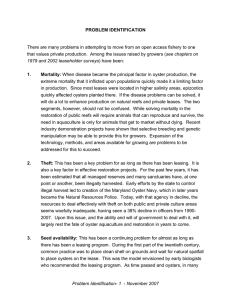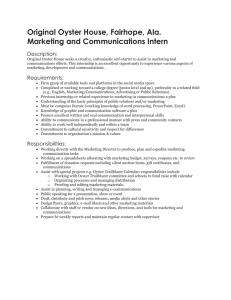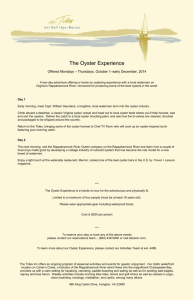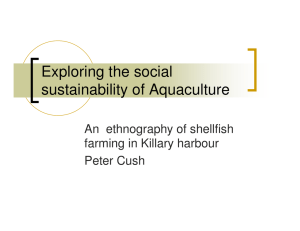CHANGING FOR GROWTH
advertisement
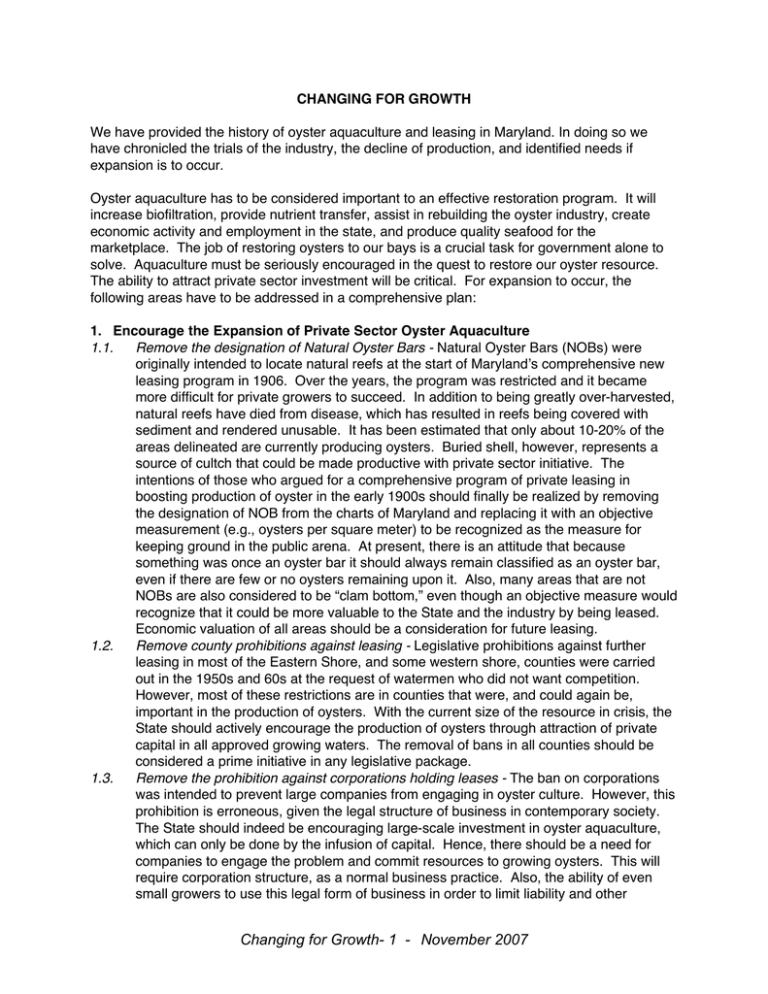
CHANGING FOR GROWTH We have provided the history of oyster aquaculture and leasing in Maryland. In doing so we have chronicled the trials of the industry, the decline of production, and identified needs if expansion is to occur. Oyster aquaculture has to be considered important to an effective restoration program. It will increase biofiltration, provide nutrient transfer, assist in rebuilding the oyster industry, create economic activity and employment in the state, and produce quality seafood for the marketplace. The job of restoring oysters to our bays is a crucial task for government alone to solve. Aquaculture must be seriously encouraged in the quest to restore our oyster resource. The ability to attract private sector investment will be critical. For expansion to occur, the following areas have to be addressed in a comprehensive plan: 1. Encourage the Expansion of Private Sector Oyster Aquaculture 1.1. Remove the designation of Natural Oyster Bars - Natural Oyster Bars (NOBs) were originally intended to locate natural reefs at the start of Marylandʼs comprehensive new leasing program in 1906. Over the years, the program was restricted and it became more difficult for private growers to succeed. In addition to being greatly over-harvested, natural reefs have died from disease, which has resulted in reefs being covered with sediment and rendered unusable. It has been estimated that only about 10-20% of the areas delineated are currently producing oysters. Buried shell, however, represents a source of cultch that could be made productive with private sector initiative. The intentions of those who argued for a comprehensive program of private leasing in boosting production of oyster in the early 1900s should finally be realized by removing the designation of NOB from the charts of Maryland and replacing it with an objective measurement (e.g., oysters per square meter) to be recognized as the measure for keeping ground in the public arena. At present, there is an attitude that because something was once an oyster bar it should always remain classified as an oyster bar, even if there are few or no oysters remaining upon it. Also, many areas that are not NOBs are also considered to be “clam bottom,” even though an objective measure would recognize that it could be more valuable to the State and the industry by being leased. Economic valuation of all areas should be a consideration for future leasing. 1.2. Remove county prohibitions against leasing - Legislative prohibitions against further leasing in most of the Eastern Shore, and some western shore, counties were carried out in the 1950s and 60s at the request of watermen who did not want competition. However, most of these restrictions are in counties that were, and could again be, important in the production of oysters. With the current size of the resource in crisis, the State should actively encourage the production of oysters through attraction of private capital in all approved growing waters. The removal of bans in all counties should be considered a prime initiative in any legislative package. 1.3. Remove the prohibition against corporations holding leases - The ban on corporations was intended to prevent large companies from engaging in oyster culture. However, this prohibition is erroneous, given the legal structure of business in contemporary society. The State should indeed be encouraging large-scale investment in oyster aquaculture, which can only be done by the infusion of capital. Hence, there should be a need for companies to engage the problem and commit resources to growing oysters. This will require corporation structure, as a normal business practice. Also, the ability of even small growers to use this legal form of business in order to limit liability and other Changing for Growth- 1 - November 2007 1.4. benefits of incorporation, should not be compromised. In short, this is a legislative relic that requires deletion. Support development of wide-scale Aquaculture Enterprise Zones - AEZs were conceived to provide ease of permitting, effective protection of product by clustering producers, and coupled with financial assistance programs. Additionally, it is hoped that subareas within these zones would be designated for bottom, near bottom, and surface culture areas. This would allow multiple culture methods to be used within them and provide all growers with an area that could be more effectively monitored and patrolled. Initial plans call for five areas within the Chesapeake and coastal bays but these could be expanded as experience and success grows. 2. Protect Against Theft 2.1. Expand penalties for theft of oysters - It has long been a simple fact that theft of oysters is carried out when penalties are merely a “cost of doing business,” that is, if the probability of getting caught and the penalties that result are less than the potential return, the crime grows. As thieves gain financially, it attracts others to participate. As noted by several watermen years ago, illegal dredging for oysters years back only started to decline when the penalties included the taking of boats and gear and otherwise making the crime costly to criminals. With the current rash of illegal harvesting affecting public and private oyster resources, even those such as managed reserves intended to reward harvesters, the problem is one of epidemic proportion. It is also one that will need to be seriously addressed to bring a solution. It is a paradox that if a person is caught illegally jacklighting deer, which are an abundant resource in the state, their vehicle and guns are taken away along with a very high fine and revocation of their hunting license. If someone is caught illegally dredging oysters, an imperiled resource, they are allowed to keep the vessel, if not the gear, and the fines are not great. There needs to be a serious move to make this a serious violation and to remove criminals from the industry. 2.2. Expand the resources of the Maryland Natural Resources Police - The force is the only one capable of meeting the challenge of protecting the public and private oyster resources. In recent years the force has been combined with the Park Police, and had its missions increased while seeing its ranks fall to low levels. Projected retirements within the next few years will further reduce the force to dangerously low levels. If the oyster resources that have been created through public funding, and the projected increase in private crops through expansion of aquaculture, are not well protected by this force, it will make little sense to expend taxpayer funds. This must be considered a major part of the overall restoration strategy, with an increase in the personnel, vehicles, equipment and resources to operate effectively. 2.3. Educate the legal system on the seriousness of the crime - The problem of convicting and penalizing thieves is a tripartite problem. It must combine effective field enforcement of the MNRP, determined prosecution by states attorneys, and severe punishment by judges. To date, this has not occurred. Prosecutors must recognize that thieves are taking either state property or private property and proceed with vigorous and well-organized cases against violators. Just as importantly, judges must recognize that this theft is no less important than that of breaking into other businesses and stealing property. There must be a concerted effort to educate both prosecutors and judges in cases against thieves so that effective punishment can be rendered. Providing educational workshops for these groups, as well as continued written material about Changing for Growth- 2 - November 2007 2.4. 2.5. seriousness of the offenses should be a priority in order to gain a more effective judicial system. Utilize innovative technology for protection - Many innovations have been developed for observation and tracking for the U.S. military. This technology can be adapted to protection of public and private oyster resources. This should be fully investigated by enforcement personnel by contacting purveyors of potential technology to judge its application and potential effectiveness in tracking lawbreakers and safeguarding growing areas. Types of equipment, training for its use, and introduction of resulting information when prosecuting cases should be included in an evaluation program. Acquisition of advanced technology should be a part of an overall strategy for supporting restoration and an annual item in the MNRP budget. Organize a summit of the legal system to address the problem - It is suggested that the highest administrative levels of MDNR organize a summit of enforcement, prosecution, and judges in order to make known the seriousness of offenses against the oyster resources. This meeting should be used to begin a program that will reach all levels of the judiciary, creating the same type of awareness as the issue of operating vehicles under the influence of alcohol and drugs, and monitoring follow up. 3. Provide Incentives for Investment 3.1. Institute a cost-share program for watermen - In order to bring watermen into the ranks of oyster growers, there should be a cost-share program instituted similar to those for other forms of agriculture. Creating a program that could help fund some of the cost of equipment, larvae, and cultch for interested watermen could assist in moving these individuals from harvesting to growing oysters. Many watermen are small operators with limited capital who would not otherwise be able to arrange the financing for such a venture. Cost-share programs could either be set up as grants or as a loan with repayment into a revolving fund so that others could utilize the money for future entry or expansion purposes. A program of this type should be limited to watermen who can demonstrate participation in the industry within a recent time frame, in order to ensure that only those who are entitled to entry in the program are using it. 3.2. Investigate MARBIDCO potential for support - This program, for Maryland resource based industries, operated by the Maryland Department of Business and Economic Development (MDBED), provides financing for business. Their programs should be investigated for application to oyster aquaculture. If these do not qualify, or if it is deemed necessary to expand their current activities with aquaculture, sufficient support should be obtained through legislative appropriations. Aquaculture is another legitimate resource based industry and should benefit from the activities of MDBED and the MARBIDCO project area. 3.3. Provide guarantees for private sector financing - Maryland at one time funded a Seafood and Aquaculture Loan Fund that was to be revolving. As loans were repayed, the money would be returned back to the fund for future loans. None of the loans ever made under that program were ever paid back. Therefore the fund passed out of existence. Government loan programs may often be intended for industries that are new and inherently risky. In many cases they have very poor repayment records. Some of those that have been successful, however, are guarantees that help minimize the exposure that a financial institution may have. This helps to underpin private loans while still keeping them in the private sector marketplace where they are often judged more rationally than some government programs. For aquaculture, this would be a natural Changing for Growth- 3 - November 2007 way to interest private financiers to provide capital to the aquaculture industry while minimizing the amount that the state would have to invest directly. 4. Provide Research Targeting Defined Industry Problems 4.1. Provide funding for performance trials for selected lines - Recent advances in selected lines of oysters for aquaculture, along with development of triploids, have led to experiments in Virginia in which growth and survival are significantly enhanced. There is a need to test those lines in conjunction with the Virginia trials, providing comparisons in Upper Bay areas of lower salinity. This should be a priority project to develop information that could be of use to industry in developing lines adapted to particular environmental conditions in various areas, similar to what has been done for agricultural crops. 4.2. Provide funding for hatchery research - The UM Horn Point hatchery has provided service to aquaculture for over three decades. It stands as the state-of-the-art facility on the East Coast and has been of value in developing methods for private culture, as well as restoration. It should continue to be funded to research large-scale restoration and hatchery methods for the Chesapeake Bay. Resulting information could provide important information for commercial hatcheries needed to build a profitable aquaculture industry. 4.3. Research into the renovation of existing shell deposits - While large-scale dredging of shell deposits in the Upper Chesapeake Bay has been halted, there is a need to explore methods of obtaining the cultch upon which commercial and restoration aquaculture will be built. One option lies in the millions of bushels of shell in place on public and private grounds already. In some cases, this is covered with a light overburden of sediment while in others this may involve a foot or more. If this shell could be returned to the immediate bottom and cleaned, it could provide the necessary stabilization required for successful aquaculture. This research should target three objectives: a) mining shell in place on defunct NOBs; b) reclaiming old shell plants; and c) developing agricultural-type equipment to turn over shell from bottom sediment and place it back on top. Ongoing research in this area is considered a priority for successful private and public activity. 5. Provide Training for Growers 5.1. Provide funding for an annual educational conference - University of Maryland extension work with private growers began with organizing a conference in 1979. This grew to an annual meeting and provided industry education and a forum for the discussion of problems and solutions for many years. This should be considered an important industry gathering and feedback mechanism for scientists and regulators. Annual funding for this meeting has been requested by the Aquaculture Coordinating Council. It was requested as a line item for Maryland Cooperative Extension, with the Council providing guidance and oversight in development of the program. 5.2. Provide educational programs for growers and hatchery operators - There is a critical need for training programs to provide support for those entering the industry and those wanting to make their businesses more profitable. While UM Cooperative Extension has provided programs over the past 25 years to growers, there is a need to expand them if the industry is going to expand. Funding for continued support of workshops, demonstration projects, and conferences will be required for this action. Changing for Growth- 4 - November 2007
